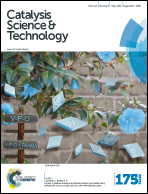Catalytic dehydrogenation of isobutane over a Ga2O3/ZnO interface: reaction routes and mechanism†
Abstract
In this work, physical mixtures of ZnO and Ga2O3, even with a small amount of Ga2O3, were found to exhibit greatly enhanced catalytic performance for isobutane dehydrogenation compared to their individual components, namely solely ZnO or Ga2O3. The activity test results under different packing patterns indicated that, the interface between the two component oxides played a crucial role in improving the dehydrogenation performance. Moreover, consistent with the highest dehydrogenation reactivity, the largest activation energy for isobutane desorption over ZnO–Ga2O3 was determined using an isobutane-TPD test. The observed synergistic effect of ZnO and Ga2O3 could be understood as being that, Lewis acid sites provided by Ga2O3 promoted the heterolytic cleavage of C–H bonds in isobutane over ZnO, thereby increasing the isobutane conversion. On the surface of ZnO–Ga2O3, a double-site adsorption of isobutane was further speculated through FT-IR spectra analysis, and one-step decomposition was probably the actual reaction pathway of isobutane. In addition, from understanding that catalyst deactivation was caused by highly graphitized coke deposition, the deactivated catalyst was regenerated through air combustion, and good catalyst stability was demonstrated through continuous reaction–regeneration cycles.


 Please wait while we load your content...
Please wait while we load your content...